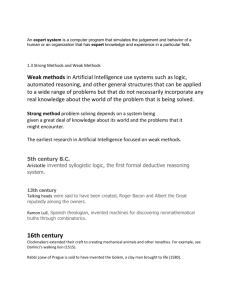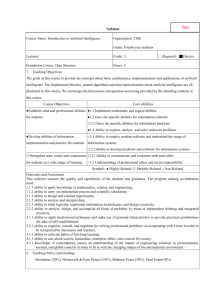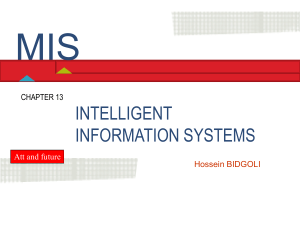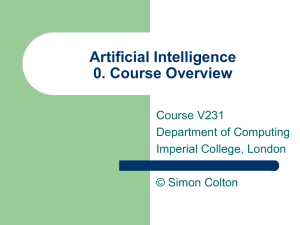Glossary
advertisement
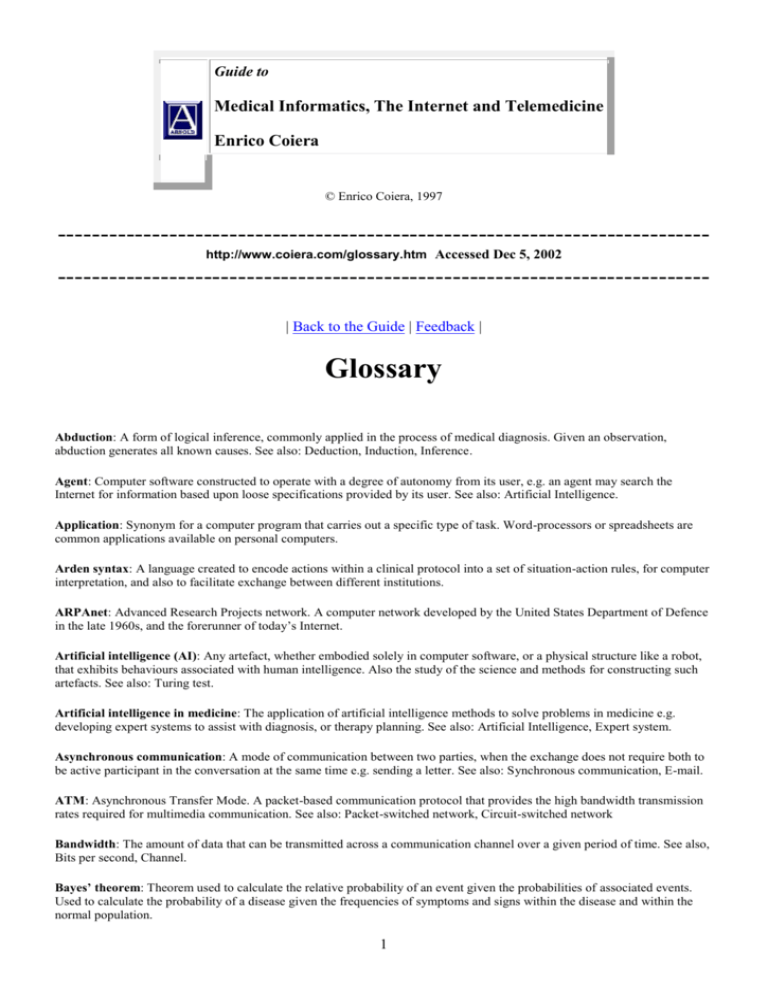
Guide to Medical Informatics, The Internet and Telemedicine Enrico Coiera © Enrico Coiera, 1997 ---------------------------------------------------------------------------http://www.coiera.com/glossary.htm Accessed Dec 5, 2002 ---------------------------------------------------------------------------| Back to the Guide | Feedback | Glossary Abduction: A form of logical inference, commonly applied in the process of medical diagnosis. Given an observation, abduction generates all known causes. See also: Deduction, Induction, Inference. Agent: Computer software constructed to operate with a degree of autonomy from its user, e.g. an agent may search the Internet for information based upon loose specifications provided by its user. See also: Artificial Intelligence. Application: Synonym for a computer program that carries out a specific type of task. Word-processors or spreadsheets are common applications available on personal computers. Arden syntax: A language created to encode actions within a clinical protocol into a set of situation-action rules, for computer interpretation, and also to facilitate exchange between different institutions. ARPAnet: Advanced Research Projects network. A computer network developed by the United States Department of Defence in the late 1960s, and the forerunner of today’s Internet. Artificial intelligence (AI): Any artefact, whether embodied solely in computer software, or a physical structure like a robot, that exhibits behaviours associated with human intelligence. Also the study of the science and methods for constructing such artefacts. See also: Turing test. Artificial intelligence in medicine: The application of artificial intelligence methods to solve problems in medicine e.g. developing expert systems to assist with diagnosis, or therapy planning. See also: Artificial Intelligence, Expert system. Asynchronous communication: A mode of communication between two parties, when the exchange does not require both to be active participant in the conversation at the same time e.g. sending a letter. See also: Synchronous communication, E-mail. ATM: Asynchronous Transfer Mode. A packet-based communication protocol that provides the high bandwidth transmission rates required for multimedia communication. See also: Packet-switched network, Circuit-switched network Bandwidth: The amount of data that can be transmitted across a communication channel over a given period of time. See also, Bits per second, Channel. Bayes’ theorem: Theorem used to calculate the relative probability of an event given the probabilities of associated events. Used to calculate the probability of a disease given the frequencies of symptoms and signs within the disease and within the normal population. 1 B-ISDN: Broadband ISDN. A set of communication system standards for ATM systems. See: ATM, ISDN. Bit: One binary digit, in base 2. The basic unit for electronically stored or transmitted data. See also: Byte. Bits per second: A measure of data transmission rate. See also: Bit. Broadband network: General term for a computer network capable of high-bandwidth transmission rated. See also: ATM. Browser: A program used to view data e.g. examining the contents of a database or knowledge base, or viewing documents on the World Wide Web. See also: Mosaic, World Wide Web, Internet. Byte: Eight bits. Bytes are usually counted in kilobytes (1024 bytes), megabytes, and gigabytes. See also: Bit. Case-based reasoning: An approach to computer reasoning that uses knowledge from a library of similar cases, rather than by accessing a knowledge base containing more generalised knowledge, such as a set of rules. See also: Artificial intelligence, Expert system. Causal reasoning: A form of reasoning based on following from cause to effect, in contrast to other methods in which the connection is weaker, such as probabilistic association. CERN: Conseil Européan pour la Recherche Nucléaire. The European Particle Physics Laboratory. It was here that the initial set of standards were developed to create the World Wide Web. See: HTML, HTTP, WWW. Channel: The connection between two parties that mediates their communication, such as a telephone or e-mail. Circuit-switched network: A communication network that connects parties by establishing a dedicated circuit between them. See also: Packet-switched network. Client: A computer connected to a network that does not store all the data or software it uses, but retrieves it across the network from another computer that acts as a server. See also: Client-server architecture, Server. Client-server architecture: A computer network architecture that places commonly used resources on centrally accessible server computers, which can be retrieved as they are needed across the network by client computers on the network. See also: Client, Server. Clinical guideline: An agreed set of steps to be taken in the management of a clinical condition. Clinical pathway: See Clinical guideline. Clinical protocol: See Clinical guideline. Closed-loop control: Completely automated system control method in which no part of the control system need be given over to humans. See also: Open-loop control Code: In medical terminological systems, the unique numerical identifier associated with a medical concept, which may be associated with a variety of terms, all with the same meaning. See also: Term. Cognitive science: A multi-disciplinary field studying human cognitive processes, including their relationship to technologically embodied models of cognition. See also: Artificial Intelligence. Computerised protocol: Clinical guideline or protocol stored on a computer system, so that it may be easily accessed or manipulated to support the delivery of care. See also: Clinical guideline. CPR: Computer-based Patient Record. See: Electronic Medical Record. Connectionism: The study of the theory and application if neural networks. See: Neural network. CSCW: Computer supported co-operative work. The study of computer systems developed to support groups of individuals work together. See also: Groupware 2 Cybernetics: A name coined by Norbert Weiner in the 1950s to describe the study of feedback control systems and their application. Such systems were seen to exhibit properties associated with human intelligence and robotics, and so was an early contributory to the theory of artificial intelligence. Cyberspace: Popular term now associated with the Internet, which describes the notional information ‘space’ that is created across computer networks. See also: Virtual reality. Database: A structured repository for data, usually stored on a computer system. The existence of a regular and formal indexing structure permits rapid retrieval of individual elements of the database. DECT: Digital European Cordless Telephony standard, which defines the architecture for wireless voice and data communication systems restricted to campus-size areas, rather than wide-area systems that would be publicly available. Decision support system: General term for any computer application that enhances a human’s ability to make decisions. Decision Tree: A method of representing knowledge which makes structures decisions in a hierarchical tree-like fashion. Deduction. A method of logical inference. Given a cause, deduction infers all logical effects that might arise as a consequence. See also: Inference, Abduction, Induction. Distributed computing: Term for computer systems in which data and programs are distributed across different computers on a network, and shared. DTMF: Dial Tone Multifrequency. The tones generated by punching in numbers on a telephone key-pad. EDI: Electronic Data Interchange. General term describing the need for healthcare applications to be able to exchange data, requiring the adoption of agreed common standards for the form and content of the messages passing between applications. See also: HL7. Electronic mail: See E-mail. Electronic medical record: A general term describing computer-based patient record systems. It is sometimes extended to include other functions like order entry for medications and tests, amongst other common functions. EMR: See: Electronic medical record EPR: Electronic patient record. See: Electronic medical record E-mail: Electronic mail. Messaging system available on computer networks, providing users with personal mail-boxes from which electronic messages can be sent and received. Epistemology: The philosophical study of knowledge. Evidence-based Medicine: A movement advocating the practice of medicine according to clinical guidelines, developed to reflect best-practice as captured from a meta-analysis of the clinical literature. See also: Clinical guideline, Meta-analysis, Protocol. Expert system: A computer program that contains expert knowledge about a particular problem, often in the form of a set of if-then rules, that is able to solve problems at a level equivalent or greater than human experts. See also: Artificial intelligence. FAQ: Frequently Asked Questions. Common term for information lists available on the Internet which have been compiled to newcomers to a particular subject, answering common questions that would otherwise often be asked by submitting e-mail requests to a Newsgroup. Finite state machine: A knowledge representation that makes different states in a process explicit, and connects them with links which specify some transition condition that specifies how one traverses from one state to another. Firewall: A security barrier erected between a public computer network like the Internet and a local private computer network. 3 FTP: File Transfer Protocol. A computer protocol that allows electronic files to be sent and received in a uniform fashion across a computer network. Fuzzy logic: An Artificial intelligence method for representing and reasoning with imprecisely specified knowledge, for example defining loose boundaries to distinguish ‘low’ from ‘high’ values. See also: Qualitative reasoning, Artificial intelligence. Group: A group collects together a number of different codes associated with medical events, that are considered to be sufficiently similar for some purpose e.g. the determination of an appropriate reimbursement for approximately similar clinical procedures or diseases. See also: Term, Code. Groupware: A computer application that assists communication and shared working amongst groups of individuals with access to a common computer network, but who may be geographically or temporally separated. See also: CSCW. GSM: The Global System of Mobility. A widely adopted international standard for the architecture and operation of digital cellular telephony systems that can carry voice and data circuits, as well as short packet-data messages. GUI: Graphical User Interface. That part of a computer application seen and interacted with by its user. Specifically, that part of the interface that is based upon visual structures like icons, which act as metaphors for the different functions supported by the application e.g. deleting a file is enacted by dragging a visual symbol representing the file onto a trash can icon. Hardware: For a computer system, all its physical components, as distinguished from the programs and data that are manipulated by the computer. See also: Software. Heuristic: A rule of thumb that describes how things are commonly understood, without resorting to deeper or more formal knowledge. See also: Model-based reasoning. HIS: Hospital information system. Typically used to describe hospital computer systems with functions like patient admission and discharge, order entry for laboratory tests or medications, and billing functions. See also: Electronic medical record. HL7: Health Level 7. A healthcare specific communication standard for data exchange between computer appliactions. Home page: A document on the World Wide Web that acts as a front page or point of welcome to a collection of documents that may introduce an individual, organisation, or point of interest. HTML: Hypertext Mark-up Language. The description language used to create hypertext documents that can be viewed on the World Wide Web. See also: HTTP, World Wide Web. HTTP: Hypertext Transfer Protocol. Communication protocol used on the Internet for the transfer of HTML documents. See also: HTML, World Wide Web. Human-computer interaction: The study of the psychology and design principles associated with the way humans interact with computer systems. Human-computer interface: The ‘view’ presented by a program to its user. Often literally a visual window that allows a program to be operated, an interface could just as easily be based on the recognition and synthesis of speech, or any other medium with which a human is able to sense or manipulate. Hyperlink: A connection between hypertext documents, that allows a reader to trace concepts appearing in one document to related occurrence in other documents. Hypertext: A method of presenting documents electronically that allows them to be read in a richly interconnected way. Rather than following a single document from beginning to end, sections of each document are connected to related occurrences in other documents via hyperlinks, permitting ‘non-linear’ reading following concepts of interest to the reader. See also: Hyperlink, HTML, World Wide Web. ICD-9: The International Classification of Diseases, 9th edition. Published by World Health Organisation. ICD-10: The International Classification of Diseases, 10th edition. Published by World Health Organisation. 4 Induction: A method of logical inference used to suggest relationships from observations. This is the process of generalisation we use to create models of the world. See also: Deduction, Abduction, Inference. Inference: A logical conclusion drawn using one of several methods of reasoning, knowledge and data. See also: Abduction, Deduction, Induction. Information superhighway: A popular term associated with the Internet, used to describe its role in the global mass transportation of information. Information Theory: Initially developed by Claude Shannon, describes the amount of data that can be transmitted across a channel given specific encoding techniques and noise in the signal. Internet: Technically, a network of computer networks. Today, associated with a specific global computer network which is publicly accessible, and upon which the World Wide Web is based. See also: ARPAnet, World Wide Web. Intranet: A computer network, based upon World Wide Web and Internet technologies, but whose scope is limited to an organisation. An intranet may be connected to an Internet, so that there can be communication and flow of information between it and other intranets. See also: Internet, World Wide Web. IP address: The address of a computer on the Internet, that permits it to send and receive messages from other computers on the Internet. ISDN: Integrated Services Digital Network. A digital telephone network that is designed to provide channels for voice and data services. Knowledge acquisition: Sub-speciality of artificial intelligence, usually associated with developing methods for capturing human knowledge and of converting it into a form that can be used by computer. See also: Machine learning, Wxpert system, Heuristic. Knowledge-based system: See: Expert system. LAN: Local Area Network. A computer network limited to servicing computers in a small locality. See also: Intranet. Machine learning: Sub-speciality of artificial intelligence concerned with developing methods for software to learn from experience, or to extract knowledge from examples in a database. See also: Artificial intelligence, Knowledge acquisition. Mailing List: A list of email addresses for individuals. Used to distribute information to small groups of individuals, who may, for example, have shared interests. See also: E-mail. Megabyte: 1,048,576 or 2`20 bytes. See: Byte. Meta-analysis: Pooled statistical analysis of results from several individual statistical analyses of different experiments, searching for statistical significance which is not possible within the smaller sample sizes of individual studies. Model: Any representation of a real object or phenomenon, or template for the creation of an object or phenomenon. Model-based reasoning: Approach to the development of expert systems that uses formally defined models of systems, in contrast to more superficial rules of thumbs. See also Heuristic, Artificial intelligence. Modem: Modulator-demodulator. Device used for converting a digital signal into tones that can be transmitted down a telephone wire. Mosaic: The first commonly available World Wide Web browser for viewing hypertext documents, developed at CERN. Multimedia: Computer systems or applications that are able to manipulate data in multiple forms, including still and video images, sound and text. Network: Set of connected elements. For computers, any collection of computers connected together so that they are able to communicate, permitting the sharing of data or programs. 5 Neural computing: see Connectionism. Neural network: Computer program or system designed to mimic some aspects of neurone connections, including summation of action potentials, refractory periods and firing thresholds. Newsgroup: A bulletin board service provided on a computer network like the Internet, where messages can be sent by e-mail and be viewed by those who have an interest in the contents of a particular newsgroup. See also: E-mail, Internet. Object-oriented programming: Computer languages and programming philosophy that emphasises modularity amongst the elements of a program and their sharing of properties and intercommunication. Open-loop control: Partially automated control method in which a part of the control system is given over to humans. Open system: Computer industry term for computer hardware and software that is built to common public standards, allowing purchasers to select components from a variety of vendors and use them together. PABX: Public Area Branch Exchange. Telecommunication network switching station that connects telephones in an area with the wider telephone network. Packet-switched network: Computer network which exchanges messages between different computers not by seizing a dedicated circuit, but by sending a message in a number of uniformly sized packets along common channels, shared with other computers. See also: Circuit-switched network Physician’s workstation: A computer system designed to support the clinical tasks of doctors. See also: Electronic medical record. Postscript: Commercial language that describes a common format for electronic documents that can be understood by printing devices and converted to paper documents or images on a screen. Practice parameter: See: Clinical guideline. Protocol: See: Clinical guideline. PSTN: Public Switched Telephone Network, providing ordinary voice-based telephone services. Qualitative reasoning: A sub-speciality of artificial intelligence concerned with inference and knowledge representation when knowledge is not precisely defined, e.g. ‘back of the envelope’ calculations. Read codes: Medical terminology system, developed initially for primary care medicine in the UK. Subsequently enlarged and developed to capture medical concepts in a wide variety of situations. See also: Terminology. Reasoning: A method of thinking. See also: Inference. Representation: The method chosen to model a process or object for example a building may be represented as a physical scale model, drawing or photograph. See also: Reasoning, Syntax. Rule-based expert system: See: Expert system. Search engine: Computer program capable of seeking information on the World Wide Web (or indeed any large data base) based upon search criteria specified by a user. See also: World Wide Web. Semantics: The meaning associated with a set of symbols in a given language, which is determined by the syntactic structure of the symbols, as well as knowledge captured in an interpretative model. See also: Syntax. Server: A computer on a network that stores commonly used resources such as data or programs, and makes these available on demand to clients on the network. See also: Client, Client-server architecture. SGML: Standard General Mark-up Language. Document definition language used in printing, and used as the basis for the creation of HTML. See also: HTML. 6 SNOMED: The Systematised Nomenclature of Human and Veterinary Medicine. A commercially available general medical terminology, initially developed for the classification of pathological specimens. See also: Terminology. Software: Synonym for computer program. See also: Application. Synchronous communication: A mode of communication when two parties exchange messages across a communication channel at the same time, e.g. telephones. See also: Asynchronous communication. Syntax: The rules of grammar that define the formal structure of a language. See also: Semantics. Telco: Abbreviation for telecommunication company. Telemedicine: The delivery of health care services between geographically separated individuals, using telecommunication systems e.g. video conferencing. Teleconsultation: Clinical consultation carried out using a telemedical service. See also: Telemedicine. Term: In medical terminologies an agreed name for a medical condition or treatment. See also: Code, Terminology. Terminal: A screen and keyboard system that provides access to a shared computer system e.g. a mainframe or mini computer. In contrast to computers on a modern network, terminals are not computers in their own right. Terminology: A set of standard terms used to describe clinical activities. See also: Term. Turing test: Proposed by Alan Turing, the test suggests that an artefact can be considered intelligent if its behaviour cannot be distinguished by humans from other humans in controlled circumstances. See also: Artificial intelligence. URL: Universal Resource Locator. The address for a document placed on the World Wide Web. See also: World Wide Web. User interface: The view a user has of a computer program, usually understood to mean the visual look and feel of a program, but also extending to other modes of interaction, e.g. voice and touch. Virtual Reality: Computer simulated environment within which humans are able to interact in some manner that approximates interactions in the physical world. Vocabulary: See Terminology. Voice mail: Computer based telephone messaging system, capable of recording and storing messages, for later review or other processing e.g. forwarding to other users. See also: E-mail. WAN: Wide Area Network. Computer network extending beyond a local area such as a campus or office. See also: LAN. World Wide Web: An easy-to-use hypertext document system developed for the Internet allowing users to access multimedia documents. See also: Internet, CERN, HTTP, HTML, URL. WWW: See: World Wide Web. W3: See: World Wide Web. 7


